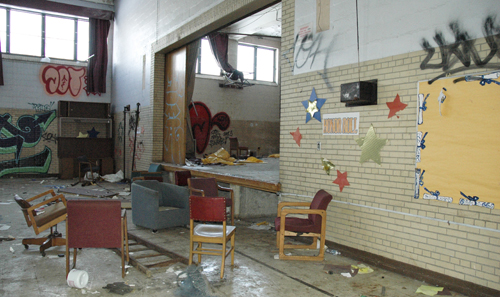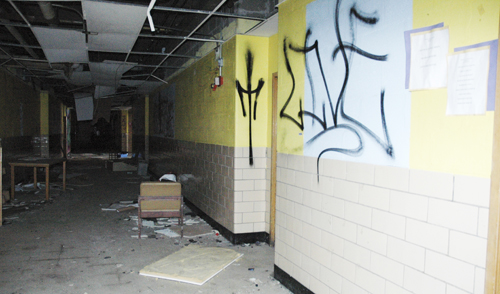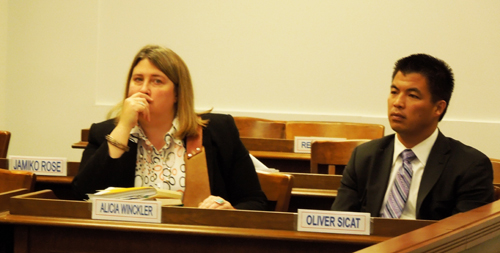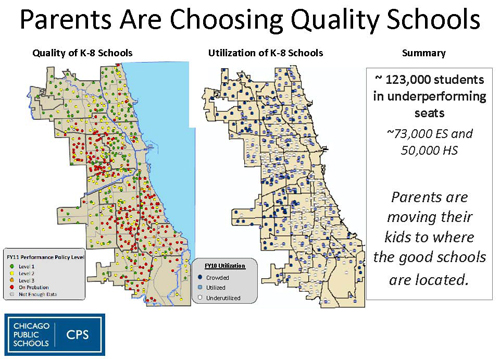Chicago Teachers Union exposes the criminal mismanagement of CPS properties -- and CPS plans to explode class sizes -- on the eve of another round of massive school closings... 'This is the result of having decision makers who are completely out of touch with the classroom' (CTU President Karen Lewi
How can CPS close more schools when it has failed to secure and manage those it has already closed? On March 7, 2013, the Chicago Teachers Union added to its critique of the Chicago Public Schools claims of a "utilization crisis" and plans to close as many as 80 of the city's real public schools while continuing to open or expand some of the most corrupt charter schools in the USA. In addition to exposing the CPS class size attacks on public education, the CTU has also begun to expose the failure of the CPS administration to protect the buildings it has already closed.
 The gymnasium of Crispus Attucks Elementary School as photographed on March 7 2013, in the midst of the claim that CPS can close additional "underutilized" schools and maintain them. Attucks was closed in 2008 because CPS claimed it could not afford to repair the school's boiler. The students were forced to go two miles south on State St. and attend Farren Elementary School. Chicago Teachers Union photo by Nate Goldbaum.On March 7, CTU investigators spent part of the day beginning a city-wide investigation into the usage CPS has put the schools it has already closed. In addition to demonstrating that CPS has devoted many of its closed schools to underutilized charter schools (who rent the buildings from CPS for $1 per year and receive other subsidies, including custodial and security services), CTU discovered that the closed Crispus Attucks school building has been allowed to become a center for gang and other illegal activities because of the failure of CPS to secure the building.
The gymnasium of Crispus Attucks Elementary School as photographed on March 7 2013, in the midst of the claim that CPS can close additional "underutilized" schools and maintain them. Attucks was closed in 2008 because CPS claimed it could not afford to repair the school's boiler. The students were forced to go two miles south on State St. and attend Farren Elementary School. Chicago Teachers Union photo by Nate Goldbaum.On March 7, CTU investigators spent part of the day beginning a city-wide investigation into the usage CPS has put the schools it has already closed. In addition to demonstrating that CPS has devoted many of its closed schools to underutilized charter schools (who rent the buildings from CPS for $1 per year and receive other subsidies, including custodial and security services), CTU discovered that the closed Crispus Attucks school building has been allowed to become a center for gang and other illegal activities because of the failure of CPS to secure the building.
In addition to challenging the CPS utilization claims in regard to class size, the CTU late on March 7 exposed the fact that CPS had abandoned some of its vacant buildings to gangs and drugs. In a press release accompanied by photographs taken on March 7, 2013, the CTU Communications Department published two photographs of several taken at the Attucks Elementary Schools.
"At present," CTU stated, "the gymnasium of the former Crispus Attucks Elementary School, 3813 S. Dearborn, can’t possibly contribute to a profitable sale for the Chicago Public Schools. The school was closed in 2008 and relocated elsewhere [the students were forced to go to Farren Elementary School at 51st and State St.]. For the past five years, the campus sits as a quasi-empty shell full of damaged desks, overturned tables and classrooms walls painted in gang graffiti. Today, Attucks is a center of illegal drug transactions and vagrant activity. Instead of a vibrant, community learning center, CPS has created an eyesore and safety hazard in Bronzeville.; SECOND PHOTO: A hallway inside the closed Crispus Attucks Elementary School is covered in gang graffiti and littered with hazardous waste. (Photos taken March 7, 2013 by Nathan Goldbaum, Chicago Teachers Union)."
 Gang graffiti in the hall of Attucks on March 7, 2013. CTU photo by Nate Goldbaum.CPS has had no explanation for the neglect of the buildings it has already closed, or any explanation of the true costs of the buildings it has leased at bargain basement prices to charter schools (for one dollar per year). In every case examined by Substance, CPS public school buildings that are being used by charter schools are additionally subsidized by CPS, which generally has been providing services such as custodians and security.
Gang graffiti in the hall of Attucks on March 7, 2013. CTU photo by Nate Goldbaum.CPS has had no explanation for the neglect of the buildings it has already closed, or any explanation of the true costs of the buildings it has leased at bargain basement prices to charter schools (for one dollar per year). In every case examined by Substance, CPS public school buildings that are being used by charter schools are additionally subsidized by CPS, which generally has been providing services such as custodians and security.
During the period of time since the closing of Attucks, CPS has had five "Chief Executive Officers." They have been Arne Duncan, Ron Huberman, Terry Mazany, Jean-Claude Brizard and, currently since October 2012, Barbara Byrd Bennett. During the brief period when Jean-Claude Brizard was CEO (May 2011 - October 2012), CPS had a "Chief Officer for Portfolio Management" who was supposedly in charge of the school system's "Portfolio" of real estate and other properties. During that time, a former charter school executive named Oliver Sicat served as "Chief Portfolio Officer" (at an annual salary of $165,000 per year) and presented several Power Points to the seven members of the Chicago Board of Education at public meetings.
 One year ago, at the February 22, 2012 meeting of the Chicago Board of Education, former charter school administrator Oliver Sicat (above right) was still serving as the CPS "Chief Portfolio Officer" at an annual salary of $162,000 per year. He had been appointed to that position by Jean-Claude Brizard in August 2011 and during his 18 months in office had specialized in presenting the Board of Education with Power Point renditions of CPS "Portfolio" reality. None of the members of the Board ever asked Sicat for an inventory of the properties in the CPS "portfolio" (the largest number of public buildings in the third largest city in the USA), nor was Sicat asked by the Board how the buildings which were not in use as schools had been secured and were being prepared for sale or other use. Above with Sicat is former Sears Holdings executive Alicia Winckler, who at the time was the CPS "Chief Talent Officer." Winckler's title had been changed at the beginning of the 2011 - 2012 school year from "Chief Human Capital Officer" after Board members felt that the title was inappropriate. Substance photo by George N. Schmidt.At no time did the members of the Board ask Sicat for a complete report on the properties owned by CPS, how they were being managed, or how the Board's properties were being secured. Sicat's Power Point presentations to the Board tended to be filled with narratives about how CPS was going to increase what at the time he referred to as "quality seats." (The narrative about "underutilized seats" began after the Board removed Jean-Claude Brizsrd as CEO following the Chicago Teachers Strike of 2012 and has been a mainstay of the talking points of the most recent CEO, Barbara Byrd Bennett. The Board has taken a number of Power Point presentations from Byrd-Bennett and her newly appointed "team" but has never asked for an inventory of the CPS properties, which are apparently no longer being referred to as a "portfolio."
One year ago, at the February 22, 2012 meeting of the Chicago Board of Education, former charter school administrator Oliver Sicat (above right) was still serving as the CPS "Chief Portfolio Officer" at an annual salary of $162,000 per year. He had been appointed to that position by Jean-Claude Brizard in August 2011 and during his 18 months in office had specialized in presenting the Board of Education with Power Point renditions of CPS "Portfolio" reality. None of the members of the Board ever asked Sicat for an inventory of the properties in the CPS "portfolio" (the largest number of public buildings in the third largest city in the USA), nor was Sicat asked by the Board how the buildings which were not in use as schools had been secured and were being prepared for sale or other use. Above with Sicat is former Sears Holdings executive Alicia Winckler, who at the time was the CPS "Chief Talent Officer." Winckler's title had been changed at the beginning of the 2011 - 2012 school year from "Chief Human Capital Officer" after Board members felt that the title was inappropriate. Substance photo by George N. Schmidt.At no time did the members of the Board ask Sicat for a complete report on the properties owned by CPS, how they were being managed, or how the Board's properties were being secured. Sicat's Power Point presentations to the Board tended to be filled with narratives about how CPS was going to increase what at the time he referred to as "quality seats." (The narrative about "underutilized seats" began after the Board removed Jean-Claude Brizsrd as CEO following the Chicago Teachers Strike of 2012 and has been a mainstay of the talking points of the most recent CEO, Barbara Byrd Bennett. The Board has taken a number of Power Point presentations from Byrd-Bennett and her newly appointed "team" but has never asked for an inventory of the CPS properties, which are apparently no longer being referred to as a "portfolio."
During the brief time since Barbara Byrd Bennett became CEO, CPS has added a "Chief Officer for Innovation and Incubation" at an annual salary of $165,000. The Incubation officer, Jack Esley, came to Chicago from Memphis in January 2013, helped along the way with a "relocation allowance" of $7,500. At the February 27 meeting of the Board of Education, Elsey presented the seven members of the Board of Education with a Power Point on charter school "accountability." Not one of the members of the Board, in the midst of what they have characterized as their "underutilization crisis," asked Elsey how the actual present properties of the Board were being managed and secured.
A CTU press release follows:
CPS Target of 30 to 40 Students in a Classroom is a Dangerous Benchmark for Utilization ‘Crisis’ If 80 schools are shuttered class sizes will balloon
CHICAGO—The Chicago Teachers Union (CTU) opposes the larger classroom sizes that Chicago Public Schools (CPS) targets as “ideal” in its threats to close 13 percent of the city’s neighborhood schools by the end of this school year. Both research and teacher experience indicate that smaller class sizes, particularly at lower grade levels, contribute to increased learning and optimal classroom activity as teachers are better able to modify instruction to meet the needs of individual children and better communicate with their parents.
A recent press report indicated that the so-called “utilization crisis” manufactured by CPS is based on the assumption that 30 the ideal number of students for an “average class size.” Because the typical Chicago classroom has far fewer than 30 students, raising the target figure to 30 made it easier for CPS to manufacture a utilization crisis and use that as justification for closing scores of public schools.
 The first discussion of what was to become the famous CPS obsession with "seats" came at the October 26, 2011 meeting of the Chicago Board of Education, when Oliver Sicat, who had been appointed "Chief Portfolio Officer" of CPS at the Board's August meeting, presented a Power Point outlining what was supposedly the mission of the "Portfolio Office" and the Portfolio officer. According to the narrative which came to dominate CPS policy discussions for the following year on the question of facilities, the mission of the "Portfolio Office" was to improve parental choice as the school system reduced the number of "underperforming seats" and supposedly increased the number of what would, in the same lexicon, would have to have been called "highly performing seats." At no time during Sicat's brief time as Portfolio chief was he asked to present the Board of Education with a simple list of the massive school system's properties, the communities in which they existed, and how they were being utilized for the public good. The scandalous deterioration of many of those properties was always known in the communities of the powerless, but only with the help of the Chicago Teachers Union and research was the hypocrisy and nonsense of the Board's approach exposed. The Power Point slide above was part of a presentation to the Board in October 2011 by Jean-Claude Brizard and Oliver Sicat. By March 2013, Brizard was gone and Sicat was on his way out the door. Substance graphic taken from the October 2011 Power Point (available at cps.edu). “What CPS has done is damaging on two fronts,” said CTU President Karen GJ Lewis. “First, they’re misleading the public with this space ‘crisis’ they’ve created using their own benchmark, and second, the benchmark they’ve set is much higher than the city and state average and what we know provides the best environment for our students to succeed.”
The first discussion of what was to become the famous CPS obsession with "seats" came at the October 26, 2011 meeting of the Chicago Board of Education, when Oliver Sicat, who had been appointed "Chief Portfolio Officer" of CPS at the Board's August meeting, presented a Power Point outlining what was supposedly the mission of the "Portfolio Office" and the Portfolio officer. According to the narrative which came to dominate CPS policy discussions for the following year on the question of facilities, the mission of the "Portfolio Office" was to improve parental choice as the school system reduced the number of "underperforming seats" and supposedly increased the number of what would, in the same lexicon, would have to have been called "highly performing seats." At no time during Sicat's brief time as Portfolio chief was he asked to present the Board of Education with a simple list of the massive school system's properties, the communities in which they existed, and how they were being utilized for the public good. The scandalous deterioration of many of those properties was always known in the communities of the powerless, but only with the help of the Chicago Teachers Union and research was the hypocrisy and nonsense of the Board's approach exposed. The Power Point slide above was part of a presentation to the Board in October 2011 by Jean-Claude Brizard and Oliver Sicat. By March 2013, Brizard was gone and Sicat was on his way out the door. Substance graphic taken from the October 2011 Power Point (available at cps.edu). “What CPS has done is damaging on two fronts,” said CTU President Karen GJ Lewis. “First, they’re misleading the public with this space ‘crisis’ they’ve created using their own benchmark, and second, the benchmark they’ve set is much higher than the city and state average and what we know provides the best environment for our students to succeed.”
CPS class sizes are already among the highest in Illinois. Last year, early grade classrooms in the city were on average larger than those in 95 percent of the districts in the rest of the state. Classrooms in CPS high schools had the fifth highest class size compared to other districts in Illinois. Many high schools and elementary schools slated for turnaround actions in recent years had multiple oversized classrooms. Tennessee’s Project STAR (Student Teacher Achievement Ratio) found that smaller class sizes had positive effects at the early childhood level (k-3), across all school locations (rural, urban, inner city, suburban), on every achievement measure and for all subjects (reading, mathematics, science, social science, language, study skills).
The study also found that students assigned to small classes of 15 students in early grades graduated on schedule at a higher rate (76 percent) than students from regular classes of 24 (64 percent). The same students also completed school with an honors diploma more often than students from regular classes and dropped out of school less often (15 percent) compared to the regular classes (24 percent).
“Smaller class sizes are a proven school policy that works, narrows the achievement gap and is manageable for both our teachers and students,” said CTU Research Director Dr. Carol Caref.
Echoing education reformers Bill Gates and New York Mayor Michael Bloomberg, CPS Communication Director Becky Carroll was quoted in the press saying that a teacher of high quality “could take 40 kids in a class and help them succeed.” Lewis said, “This just evidence of what we’re dealing with at City Hall and CPS--insults and untested hypothesis. This is the result of having decision makers who are completely out of touch—or just plain ignorant—when it comes to what’s going on in the classroom.”
Comments:
By: Paulette Lane
CPS Plan -- Destroy Bronzeville with blight!!
After CPS explodes class size in Bronzeville, they obviously intend to use vacant buildings for more citywide alternative charter high schools. Why else is a panel of alternative charter high schools jockeying for access to Bronzeville. Bronzeville aready has a slew of satellite City College GED locations (3) and 3 or more alternative high schools that are citywide. Now more citywide alternative schools are asking for access. CPS does not care about the blight that they are introducing to our community. A few months ago, a student in our area that lives is Lawndale was shooting down our business corridor during the day. He attended Youth Connection Charter on IIT Campus. We are sick of decisions being make that impact our community in a negative way, making it unsafe for the residents. This is a portion of a leeter that CPS sent out to the Bronzeville CAC on Friday and someone emailed it to me.
"Dear Bronzeville CAC-
Our next meeting will occur this upcoming Monday, March 11th, @6pm at the Chicago Urban League (4510 S. Michigan). The first half of the meeting will include a panel on alternative schools (including representatives from Prologue, Youth Connections, and Camelot) and the second half will include discussion on the Bronzeville CAC's response to the upcoming
school actions. We hope to see you there."
Carl Hurdlik
CPS Family & Community Engagement
125 S. Clark, 5th floor
Chicago, IL 60603
773.553-1554 office
773.259-0643 cell
NOTE: New e-mail: cchurdlik@cps.edu
Educate * Inspire * Transform
Well our community organization in Douglas (Gapco Community Organization), along with Alderman Fioretti, spoke out against Prologue Alternative High School coming to Douglas a few months ago and Prologue kept cancelling the zoning hearings for several months, obviously to exhaust us from fighting. We only have about 700 high schools students in Douglas and most of them leave the area for options outside the community. However, over 8,000 at risk high school students come to Douglas Community as they run from their own communities. They also bring their gang related cultures with them and their conflicts follow them to our schools sidewalks after school. This makes it difficult for our children to walk to and from school. My son has been robbed 3 times by at risk boys and I’m sick of it because the last time he was robbed at gunpoint.
Most of the students are coming from the far southside but many from the westside as well. They are coming to Youth Connection Alternative Charter on IIT Campus (citywide), Ada, S. Mckinley Alternative H.S. (citywide)located at 2920 S. Wabash (also under the Youth Connection umbrella), Urban Prep Charter from Southshore (citywide) 2710 S. Dearborn (Changed their name from Southshore to Bronzeville to camouflage where they came from) Perspectives Charter (citywide) 36th Wabash, Young Women’s Leadership Charter (citywide) 2641 S. Calumet, Dunbar Vocational H.S (citywide) ...and the list goes on for a slew of citywide schools for the “at risk”. Our community is a dumping ground for at risk students citywide and more alternative high schools are lining up to also enter our community and bring more blight to our community. CPS obviously has a design on our community to destroy it and I guess the alternative charter high schools heard that more vacant school buildings would soon be available for more charters in Douglas after school actions.
The schools in Douglas on the hit list are:
Pershing West Middle School 4th-8th
Drake
Mayo
Williams
Williams Middle School
Wells
I guess it’s easy to make decisions to destroy a community when you do not live there and yes all of these schools are in Douglas Community.


By: Jean Schwab
Attucks pleaded at budget hearing, then was closed...
I remember going to a budget meeting at King High and listening to a community person from Attucks talk about the need for a working furnace. Other schools were there asking for playgrounds, and such things. Soon after that Attucks was closed. At the time I thought that it was a shame to close it.